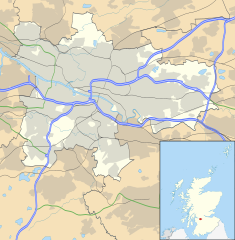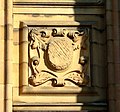
Pollokshaws is an area on the South side of the city of Glasgow, Scotland. It is bordered by the residential neighbourhoods of Auldhouse to the east, Eastwood and Hillpark to the south and Shawlands to the north, with the Glasgow South Western Line railway and the open lands of Pollok Country Park to the west. The White Cart Water flows through the area.

Pollokshields is an area in the Southside of Glasgow, Scotland. Its modern boundaries are largely man-made, being formed by the M77 motorway to the west and northwest with the open land of Pollok Country Park and the Dumbreck neighbourhood beyond, by the Inverclyde Line railway and other branches which separate its territory from the largely industrial areas of Kinning Park, Kingston and Port Eglinton, and by the Glasgow South Western Line running from the east to south, bordering Govanhill, Strathbungo, Crossmyloof and Shawlands residential areas. There is also a suburban railway running through the area.

Shawlands is a Southside suburb of Glasgow, Scotland, located two miles south of the River Clyde. The area, considered the "Heart of the Southside", is known for its independent restaurants and cafés, art scene, public parks, period terraces, and red and blond sandstone tenements. Shawlands was named one of the best places to live in Scotland in 2022 and 2023 by The Sunday Times, and one of the world's coolest neighbourhoods by Time Out Magazine with judges describing it as "the city's best area to live and socialise”. It is located between Pollok Country Park, the home of the Burrell Collection and Pollok House, and the acclaimed Victorian park Queen's Park.

Strathbungo is a mainly residential area of southern Glasgow, Scotland, bordered by the neighbourhoods of Crossmyloof to the south, Govanhill to the east and Pollokshields to the north and west. The settlement grew up as a small isolated village built along the Pollokshaws Road, one of the main arteries leading southwards from the centre of Glasgow, adjoined by the Camphill Estate, now part of Queens Park. Strathbungo lay just inside Govan parish, on its boundary with Cathcart parish, and at one time a line just north of Allison Street and Nithsdale Street formed the boundary or 'march' between the counties of Lanark and Renfrew.

Pollok Country Park is a 146-hectare (361-acre) country park located between Shawlands, Crossmyloof, and Pollok in Glasgow, Scotland. In 2007, Pollok Country Park was named Britain's Best Park, and in 2008 it was named the Best Park in Europe, beating competition from parks in Italy, France, Germany, Poland and Sweden. Despite this, by 2019 it was considered that the park was 'underused' with plans drawn up to encourage more visitors.
Glasgow Pollok was a burgh constituency represented in the House of Commons of the Parliament of the United Kingdom from 1918 until 2005, when it was replaced by Glasgow South West. It elected one Member of Parliament (MP) using the first-past-the-post voting system.

Sir John Maxwell Stirling-Maxwell, 10th Baronet, KT, DL, FRSE was a Scottish landowner, Tory politician and philanthropist.

Pollokshaws West railway station is a railway station in Glasgow, Scotland. The station is managed by ScotRail and is served by trains on the Glasgow South Western Line.
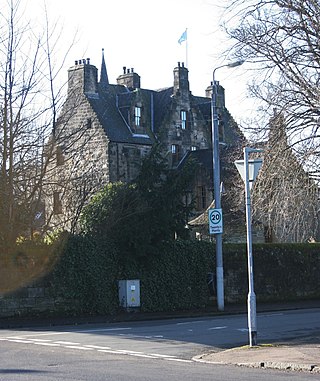
Haggs Castle is a 16th-century tower house, located in the neighbourhood of Pollokshields, in Glasgow, Scotland. The richly decorated building was restored in the 19th century, and today is once more occupied as a residence.

The Pollokshields Burgh Hall is a municipal building at the edge of Maxwell Park, Glasgow, Scotland. The burgh hall, which was briefly the headquarters of Pollokshields Burgh Council, is a Category A listed building.

The Palace Theatre & Grand Hall Complex is a multi-purpose entertainment arena complex in Green Street, Kilmarnock, Scotland. The structure, which was originally opened as a corn exchange, is a Category A listed building.

St Margaret's Church is a Category B listed church of the Scottish Episcopal Church at 355 Kilmarnock Road, Newlands, Glasgow, Scotland.

Eastwood is a residential neighbourhood in the city of Glasgow, Scotland. It is situated south of the River Clyde, and is part of the Newlands/Auldburn ward under Glasgow City Council.
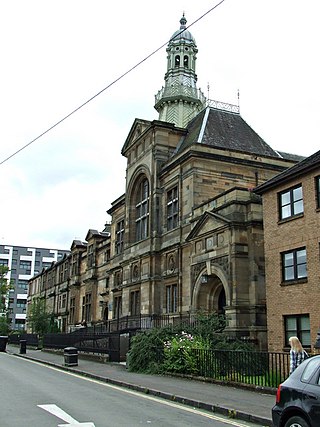
Partick Burgh Hall is a municipal facility in Burgh Hall Street, Partick, Scotland. The hall, which was the headquarters of Partick Burgh Council in the early 20th century, is a Category B listed building.

Rutherglen Town Hall is a municipal facility on the north side of Main Street in Rutherglen, Scotland. The town hall, which was the headquarters of Rutherglen Burgh Council, is a Category A listed building.

Pollokshields Parish Church is a 19th-century parish church of the Church of Scotland, named after the Pollokshields area of Glasgow, Scotland.
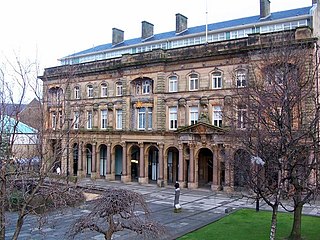
Greenock Municipal Buildings is a municipal structure in Clyde Square, Greenock, Scotland. The municipal buildings, which are the headquarters of Inverclyde Council, are Category A listed.

Clydebank Town Hall is a municipal building in Dumbarton Road, Clydebank, Scotland. The town hall, which was the headquarters of Clydebank Burgh Council, is a Category B listed building.

Dumbarton Municipal Buildings is a structure in Glasgow Road, Dumbarton, West Dunbartonshire, Scotland. The structure, which is used as a venue for weddings and civil partnership ceremonies, is a Category B listed building.
Pollok Football Club was a Scottish football team, based in Pollokshaws, now part of Glasgow.

